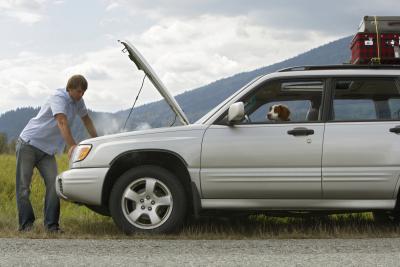
Your vehicle’s coolant system helps to keep engine heat at recommended levels for your car’s optimum operation. This system includes multiple components: a radiator, a water pump, an overflow reservoir, thermostat, temperature sensor, hoses and channels in the engine itself to remove the heat. The thermostat opens at a pre-designated temperature during engine operation to allow the coolant in. Any number of causes can reduce the coolant levels in your car.
Most overflow reservoirs come equipped with a small tube that allows the coolant to escape if the engine gets hot enough and the coolant expands past the full mark on the overflow reservoir. This can happen on hot days when you also run your air conditioner. Because of this, you need to check the reservoir level periodically to ensure coolant is between the minimum and maximum marks on the reservoir. Use the recommended mix of coolant and water for your vehicle and fill to this location.
Small pinhole leaks in the radiator will cause coolant fluids level to drop. Pinhole leaks may not be noticeable during operation, as the fluid will leak when the car is running under load. But after operation, the radiator will give off a hot moist smell and show signs of leaking underneath. Pinhole leaks will grow if not fixed. Replace the radiator or have it repaired at a radiator repair shop.
A leaking or blown head gasket will cause water to leak into the areas of the block where it was not designed to go. This will cause the coolant fluid levels to drop without any noticeable leaks under the coolant reservoir, hoses or radiator. To check for a faulty head gasket, pull the oil dipstick. Look at the color of the oil at the end of the dipstick. If it's milky in appearance, or water bubbles appear, this is a good indication of a blown head gasket.
Check all connections where hoses connect to the radiator and the engine. Make note if you see any fluid around these areas. Bad hoses may not show leaks until the engine is on. Replace any hose clamps or bad hoses. Include radiator hose inspection during oil changes or tuneups to prevent problems with the cooling system in the future.
A malfunctioning radiator cap can be the cause of fluid leaks in the coolant system. Never take a radiator cap off after the car was just shut off, as the system is under pressure. Wait until the radiator is cool to the touch before removing the cap. Replaceable caps are available from auto parts stores for a small cost.